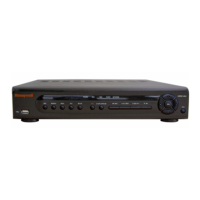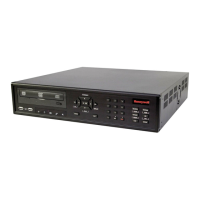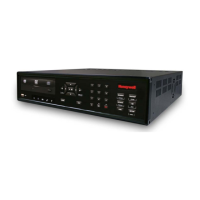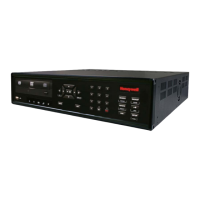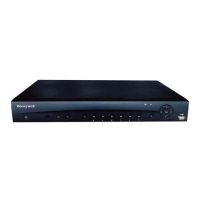Do you have a question about the Honeywell HRDP and is the answer not in the manual?
Details FCC compliance for the digital device and radio frequency energy.
Warns users about responsibility for complying with laws regarding monitoring and recording.
Declares compliance with EMC and Low Voltage Directives for electrical equipment safety.
Lists critical safety precautions for product operation, handling, and environment (points 1-15).
Continues the list of critical safety precautions (points 16-22).
Provides guidance on proper product handling, including packaging and avoiding volatile liquids.
Offers advice on placing the unit on a stable surface and away from electronic interference.
Details safe methods for cleaning the DVR unit using a damp cloth.
Recommends regular inspection maintenance for long-term operational reliability.
Explains circumstances leading to moisture condensation and how to prevent damage.
Provides safety guidelines for installing the equipment in a rack environment.
Provides an overview of the Honeywell HRDP H.264 DVR system and its capabilities.
Lists the key features and functionalities of the HRDP H.264 DVR unit.
Explains the default administrative login credentials and procedure.
Identifies and explains the functions of the DVR's front panel controls.
Identifies and explains the functions of the DVR's rear panel connectors.
Illustrates the rear panel layout for a 16-channel DVR model.
Illustrates the rear panel layout for an 8-channel DVR model.
Illustrates the rear panel layout for a 4-channel DVR model.
Describes the functions and layout of the DVR's remote control unit.
Outlines procedures for connecting monitors, video inputs, network, and audio devices to the DVR.
Explains how to connect and control PTZ cameras using the RS485 connector.
Details how to wire external devices to the DVR's alarm input connectors.
Explains how to connect external devices like buzzers or lights to the DVR's relay outputs.
Provides instructions for mounting the DVR unit into a standard equipment rack.
Step-by-step instructions for powering on the DVR and initial display.
Explains how to start up and shut down the DVR using the front panel power button.
Describes how to assign unique IDs for controlling multiple DVRs with one remote.
Explains navigation of the DVR's setup menus for configuration.
Guides users through defining global recording settings for an easy and custom schedule.
Provides instructions on how to upgrade the DVR's firmware using USB or CD/DVD.
Explains the process of formatting Hard Drives and USB devices for DVR use.
Configures options for the DVR to overwrite old data when the hard drive is full.
Details how to check the HDD for errors or potential failures.
Enables S.M.A.R.T. technology to detect signs of HDD failure and set thresholds.
Details the steps to create new user accounts and assign permissions and camera visibility.
Describes how to import and export current system settings.
Provides the correct procedure for safely shutting down the DVR system.
Covers channel setup, naming, and hiding cameras.
Guides users on adjusting brightness, contrast, and color settings for cameras.
Details the setup for Pan/Tilt/Zoom cameras, including baud rate, ID, and protocol.
Allows configuration of SPOT OUT connections and live view camera sequencing.
Enables adjustment of display transparency, resolution, and OSD elements for monitors.
Defines recording parameters like resolution, IPS, quality, and pre/post-alarm settings.
Allows users to set recording schedules and select recording modes (Continuous, Motion, Sensor).
Allows scheduling recordings for specific holidays.
Explains how to activate instant recording using the remote control or interface.
Guides on associating cameras with audio channels and enabling audio recording.
Configures motion detection sensitivity, areas, and triggers for recording events.
Step-by-step guide to configure motion detection areas and recording parameters.
Details how to configure sensor types (Normally Open/Closed) and alarm signals.
Configures alarm signals for relays and the function triggered by power loss.
Configures S.M.A.R.T. HDD alarms based on temperature thresholds.
Defines actions to be taken when events occur, such as triggering alarms or PTZ presets.
Configures the Alarm Monitor to send event information to a remote client.
Configures network parameters like IP address, ports, DDNS, and transfer speed.
Sets up serial device connections for external controllers.
Configures email notifications for various DVR events and recipients.
Displays system logs for user activity and software/hardware version details.
Shows the status of the DVR's disk storage, including usage and overwrite settings.
Displays the current recording status for each camera channel.
Shows the status of audio channels, including volume and two-way audio settings.
Displays the status of connected sensor inputs and alarm relays.
Shows the current network connection status and IP configuration.
Displays the status of motion, sensor, video loss, and alarm events.
Covers the process of logging into the DVR system.
Provides the default credentials for the administrator account.
Explains how to view live video feeds from cameras.
Describes how to select individual camera channels for live viewing.
Explains the meaning of icons displayed on the screen indicating system mode or status.
Details the functions available through the mouse-over menu in live mode.
Lists options available via the popup menu by right-clicking the live screen.
Explains the meaning of "No Signal" and "No Permission" warnings on the display.
Details how to use the PTZ popup menu for camera control.
Guides on setting and saving specific PTZ camera positions.
Explains how to search recorded video on the DVR for specific times or events.
Describes methods for finding recorded video using time bars and search tools.
Allows archiving video clips directly from the search playback interface.
Provides a method for searching recordings by selecting specific dates and times.
Enables quick navigation to the oldest or latest recorded video frames.
Details how to find particular events and export event logs.
Used for finding recorded data after time changes related to Daylight Savings.
Lists display options available within the search mode popup menu.
Explains how to back up recorded data onto CD/DVD or USB devices.
Describes how backup files are saved by date and how to view them.
Addresses deinterlacing for smooth playback and watermark verification for file integrity.
Guides on playing recorded video on a PC using the proprietary media player.
Explains the playback controls and functions within the backup viewer application.
Details functions for configuring the backup viewer and saving images or videos.
Provides instructions on obtaining and installing the latest firmware release for the DVR.
Explains how to play recorded video on a PC using the backup media player.
Describes buttons for viewing cameras in different layouts and full-screen mode.
Guides on exporting and saving DVR system configurations.
Explains how to import previously saved system configuration profiles.
Details system requirements and steps for establishing remote access to the DVR.
Lists the minimum hardware and software specifications for remote access.
Lists the recommended hardware and software specifications for optimal remote access.
Steps to configure network settings on the DVR for remote connectivity.
Guides on installing and setting up the remote software to connect to the DVR.
Provides the default username and password for remote software access.
Steps to open the remote software and connect to the DVR server.
Explains how to connect and switch between multiple DVRs using the remote software.
General guidance on using the remote software interface.
Describes how to synchronize the DVR's time and date with the PC.
Outlines the buttons and features displayed on the DVR's live view screen.
Explains how camera status (recording, motion) is displayed in the video area.
Describes buttons for viewing cameras in different layouts and full-screen mode.
Explains how remote users can access DVR setup options.
Provides a visual guide to the search interface elements and controls.
Explains the functions of the playback controls (rewind, play, stop, frame advance).
Guides users on selecting dates, times, and cameras for basic video searches.
Details how to adjust image brightness and zoom levels during playback.
Explains how to zoom into specific areas of an image using mouse controls.
Guides on locating and printing frames from recorded video.
Describes how to export recorded video clips in JPG or AVI formats.
Step-by-step instructions for exporting video clips, including file type and compression settings.
Explains how to use the timeline graph to locate hours with recorded video.
Guides on selecting dates and cameras to view status information.
Describes how to clean images affected by interlacing issues.
Explains how to access PTZ controls via onscreen menus or graphical controllers.
Details methods for controlling PTZ camera movement and functions.
Guides on using the on-screen graphical controller for PTZ camera movement and adjustments.
Explains how to use the on-screen compass to control PTZ camera direction and movement.
Step-by-step guide to connect to the DVR using Microsoft Internet Explorer.
Explains how to search for recorded video through the web viewer interface.
Guides on performing basic and status searches through the web viewer.
Describes how to clean images for better viewing within the web viewer.
Details how to print images captured from the web viewer.
Explains how to export video clips in JPG or AVI format from the web viewer.
Guides on assigning status levels (Default, Review, Critical) to alarm events.
Details how to link the DVR to the Alarm Monitor software for event notification.
Configures options like popup messengers and sound alerts for alarm events.
Allows adding custom text entries to the alarm confirmation list.
Explains how to filter alarm events by status level, date, type, and confirmation.
Describes how to open and use the search alarm window to locate event video.
Guides on playing back recorded video associated with alarm events.
Details the process of exporting alarm video clips in JPG or AVI format.
Explains how to use the Digital Verifier to check the authenticity of exported images and videos.
Introduces FVMS software for multi-site management and DVR connection.
Provides a list of DVR buttons and their corresponding functions.
Explains the meaning of the LED indicators on the DVR for power, HDD, network, etc.
Describes the function of Enter and Exit buttons for navigation and data input.
Explains the purpose of various function buttons like Search, Focus, Zoom, and Backup.
Details the use of numeric buttons for input and the Record button for instant recording.
Explains how directional and playback control buttons are used for navigation and playback.
Answers common questions about embedded Linux, upgrades, and factory resets.
Addresses questions about monitoring live video from specific cameras.
Covers FAQs related to recording, video search, data backup, network issues, and miscellaneous topics.
